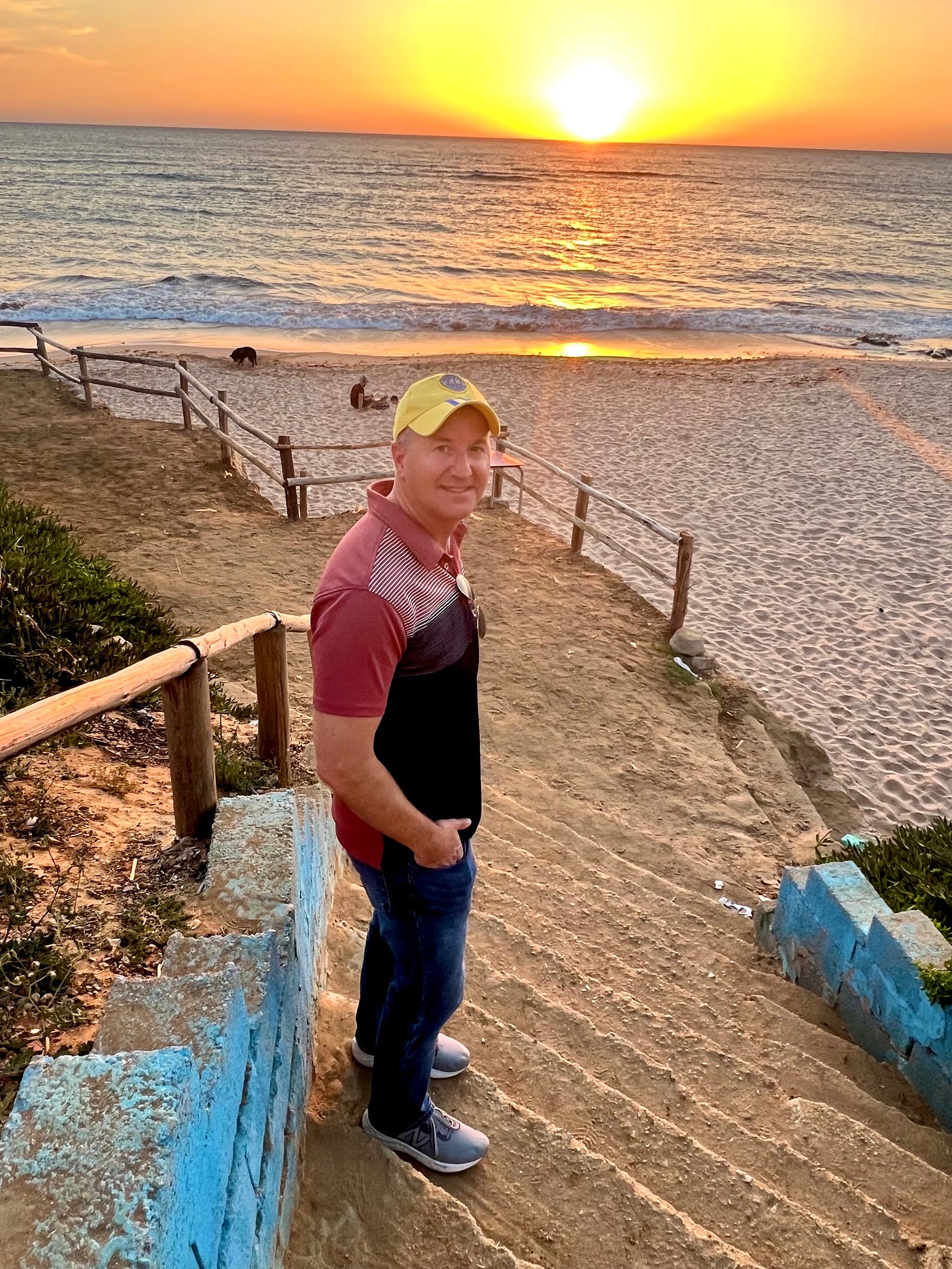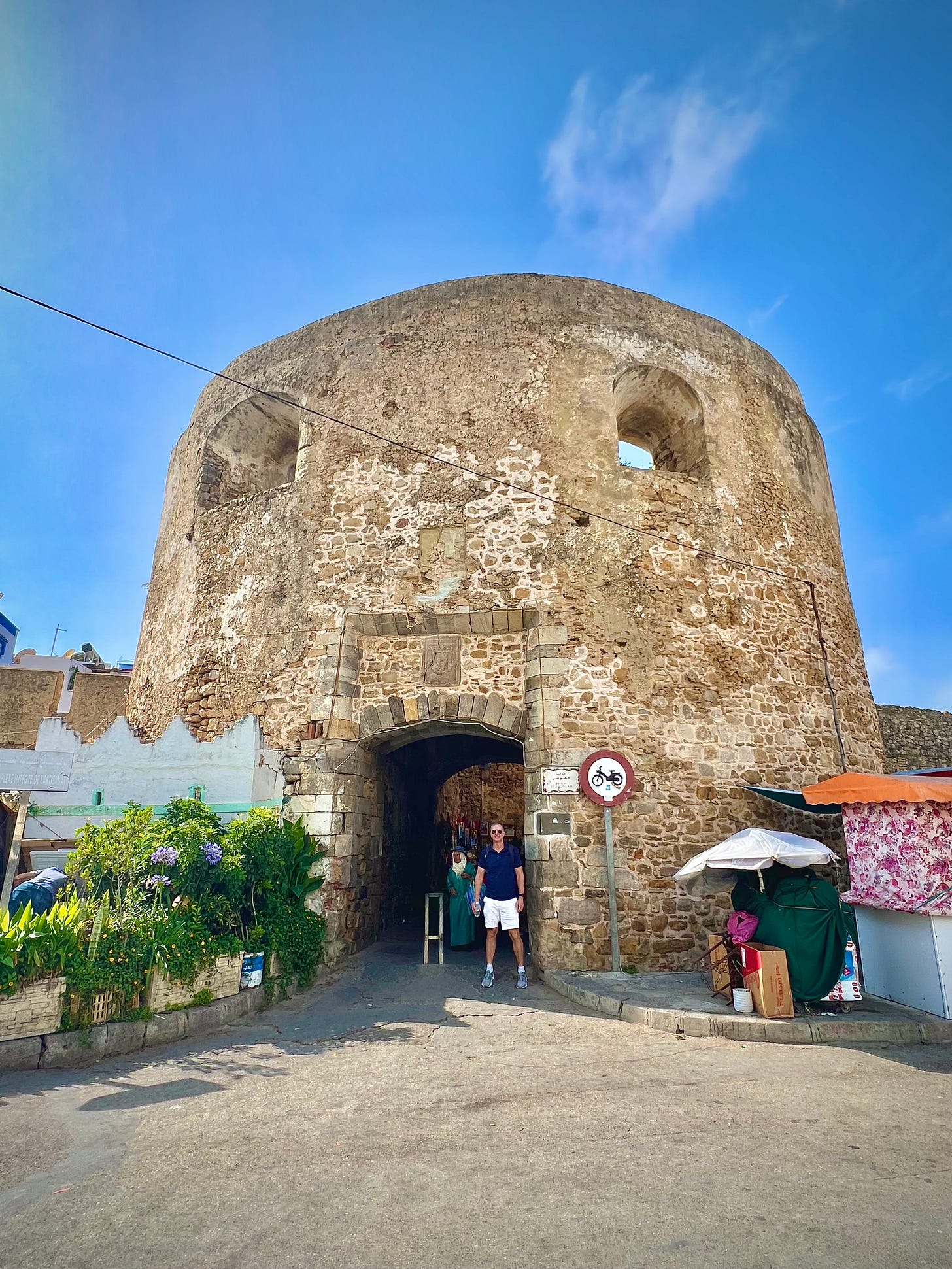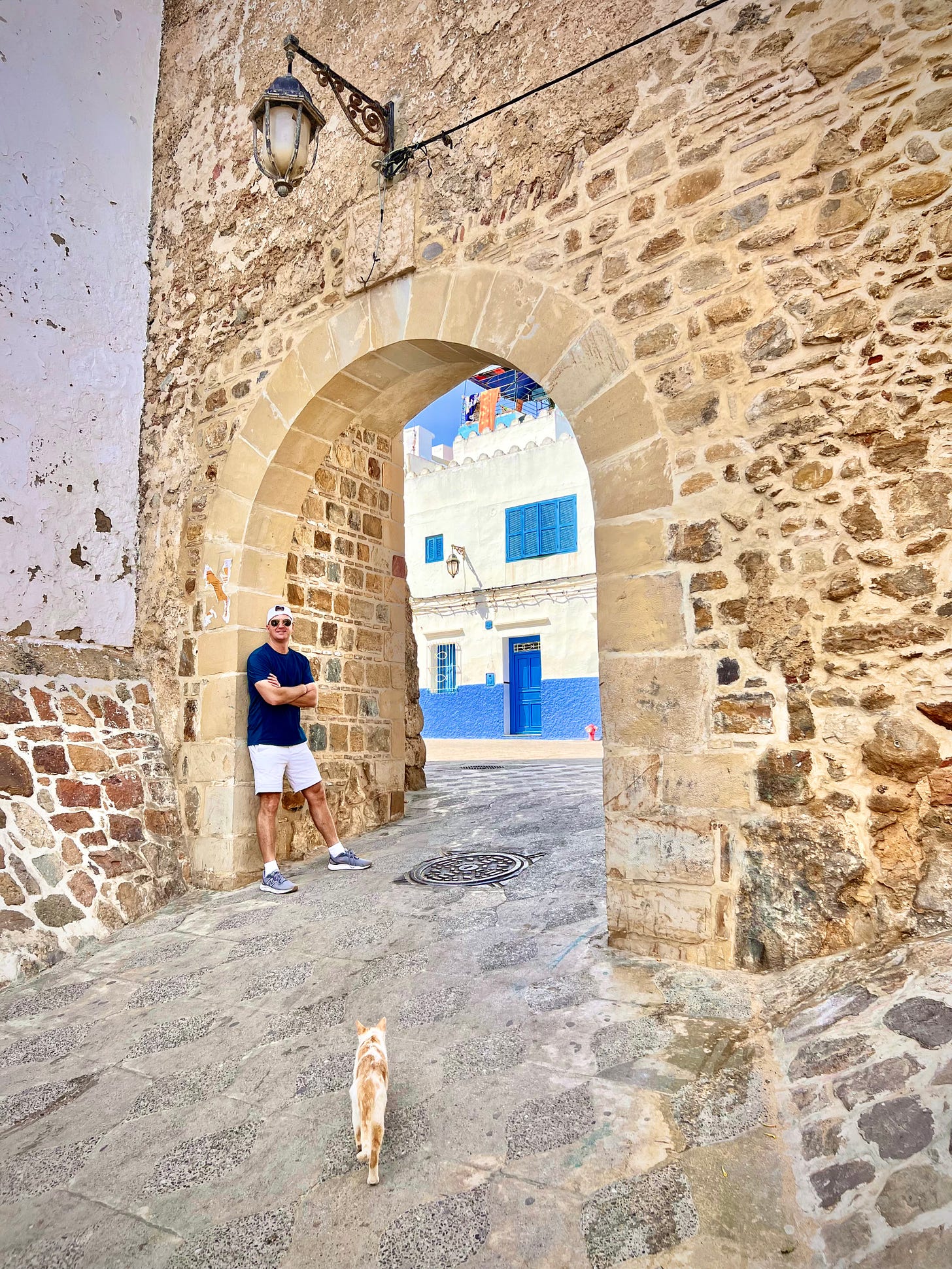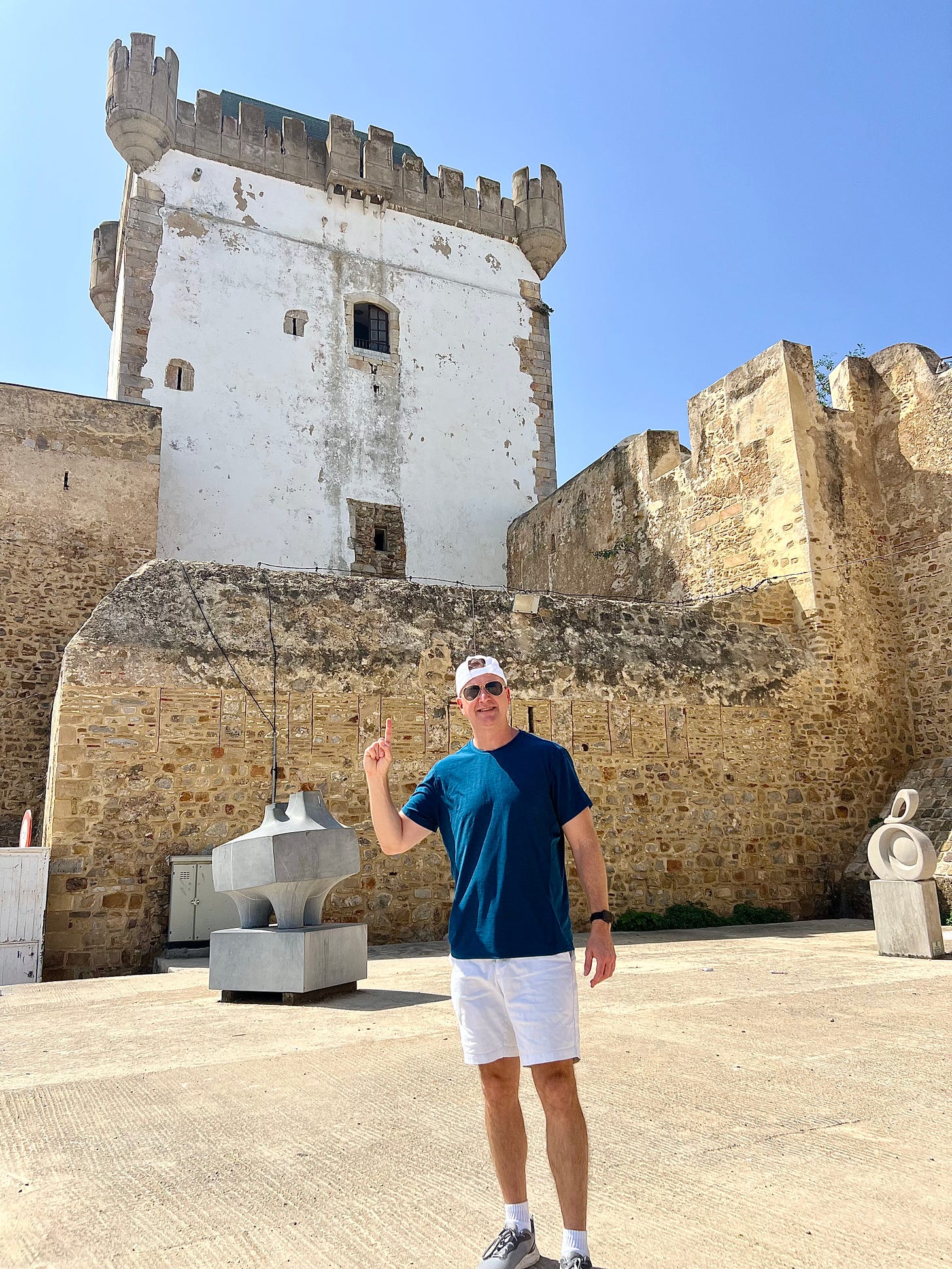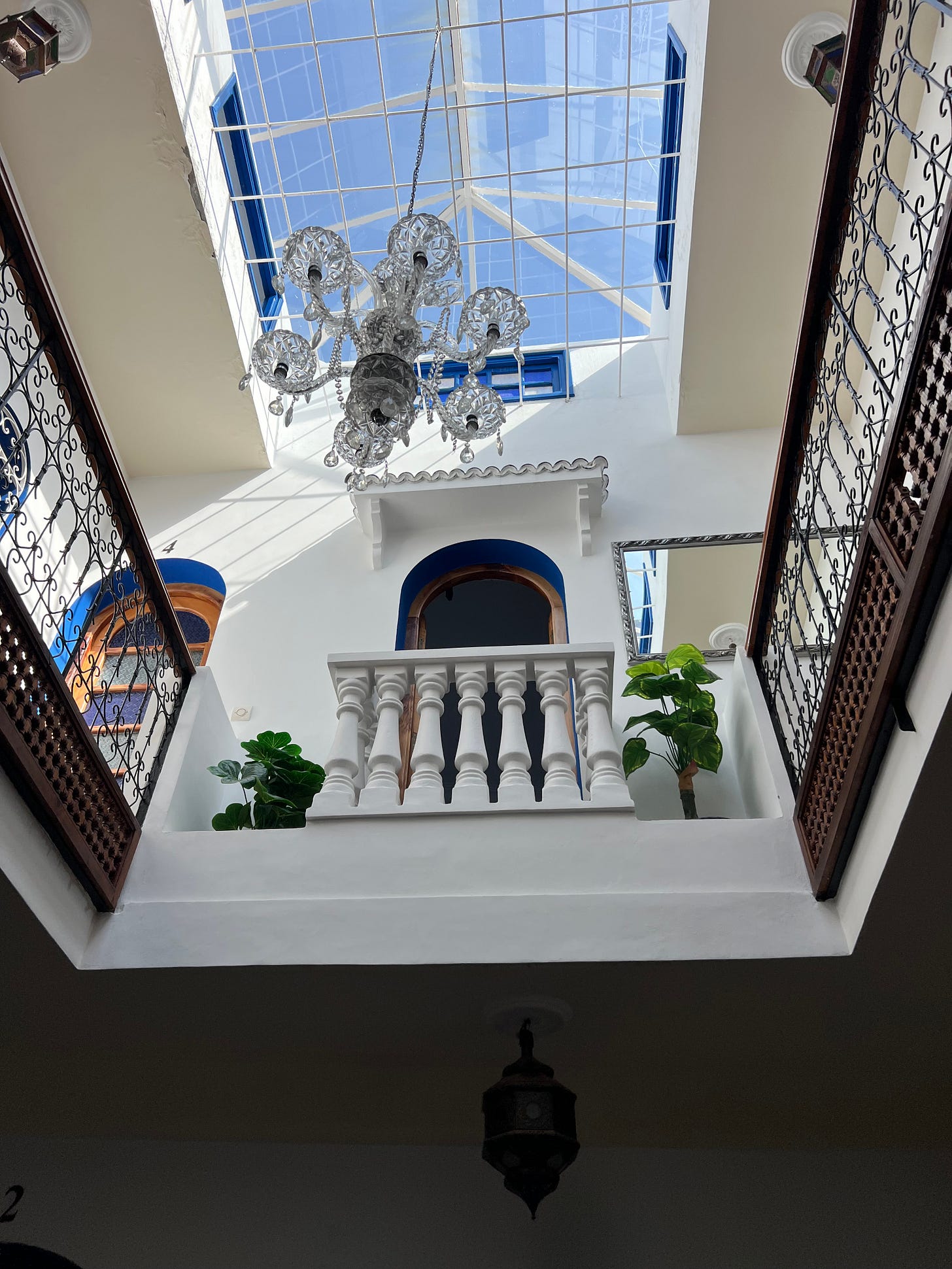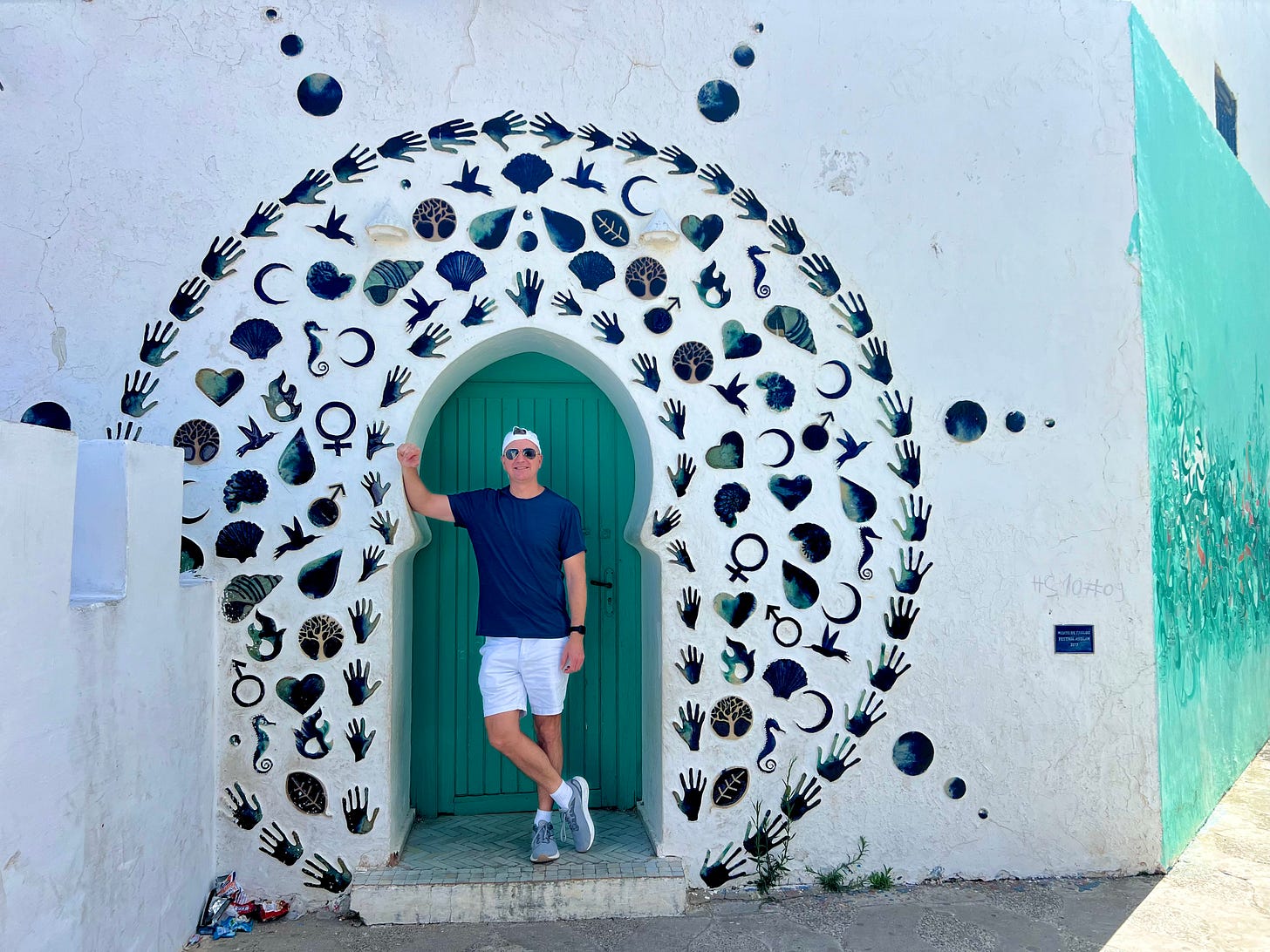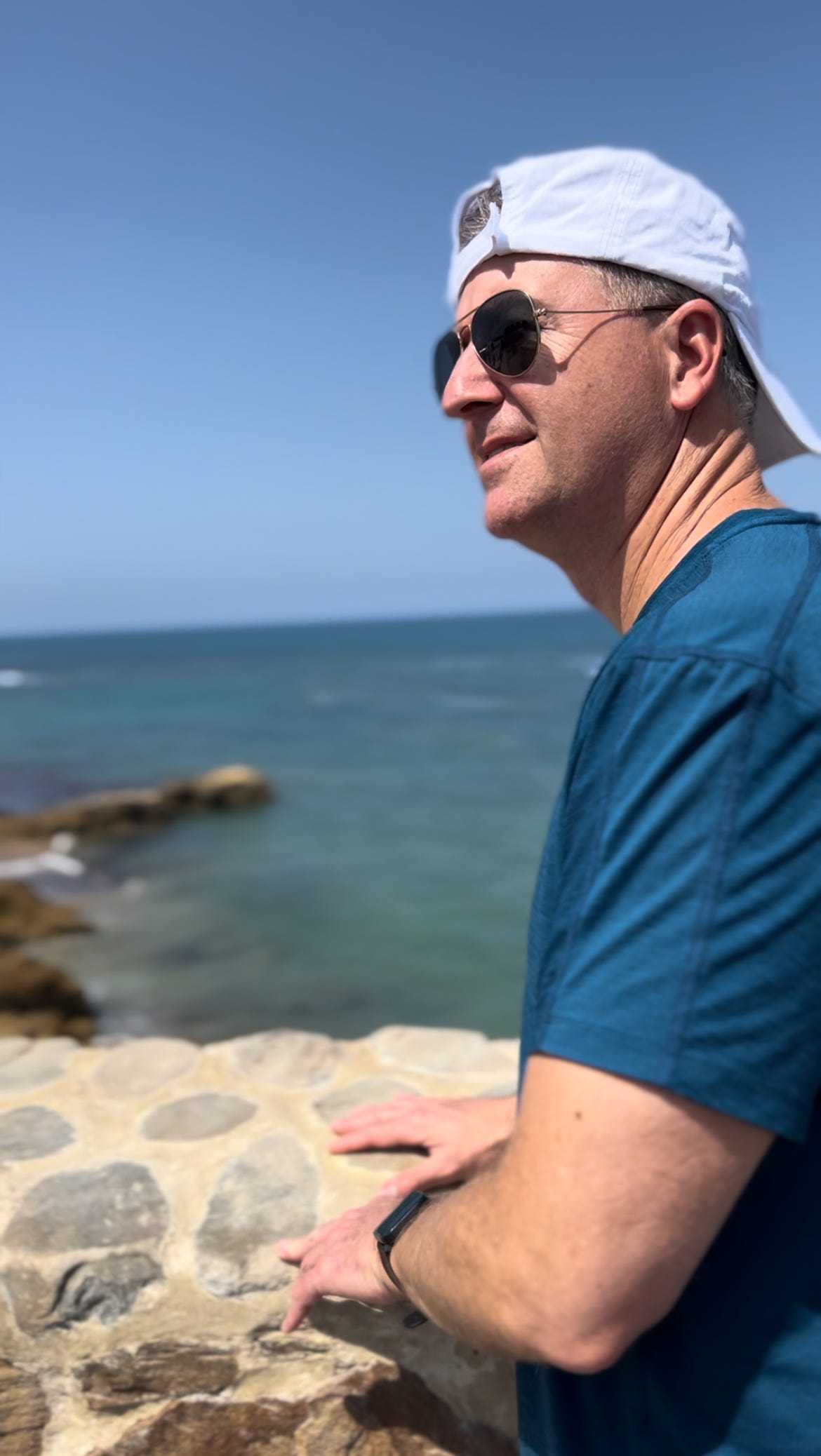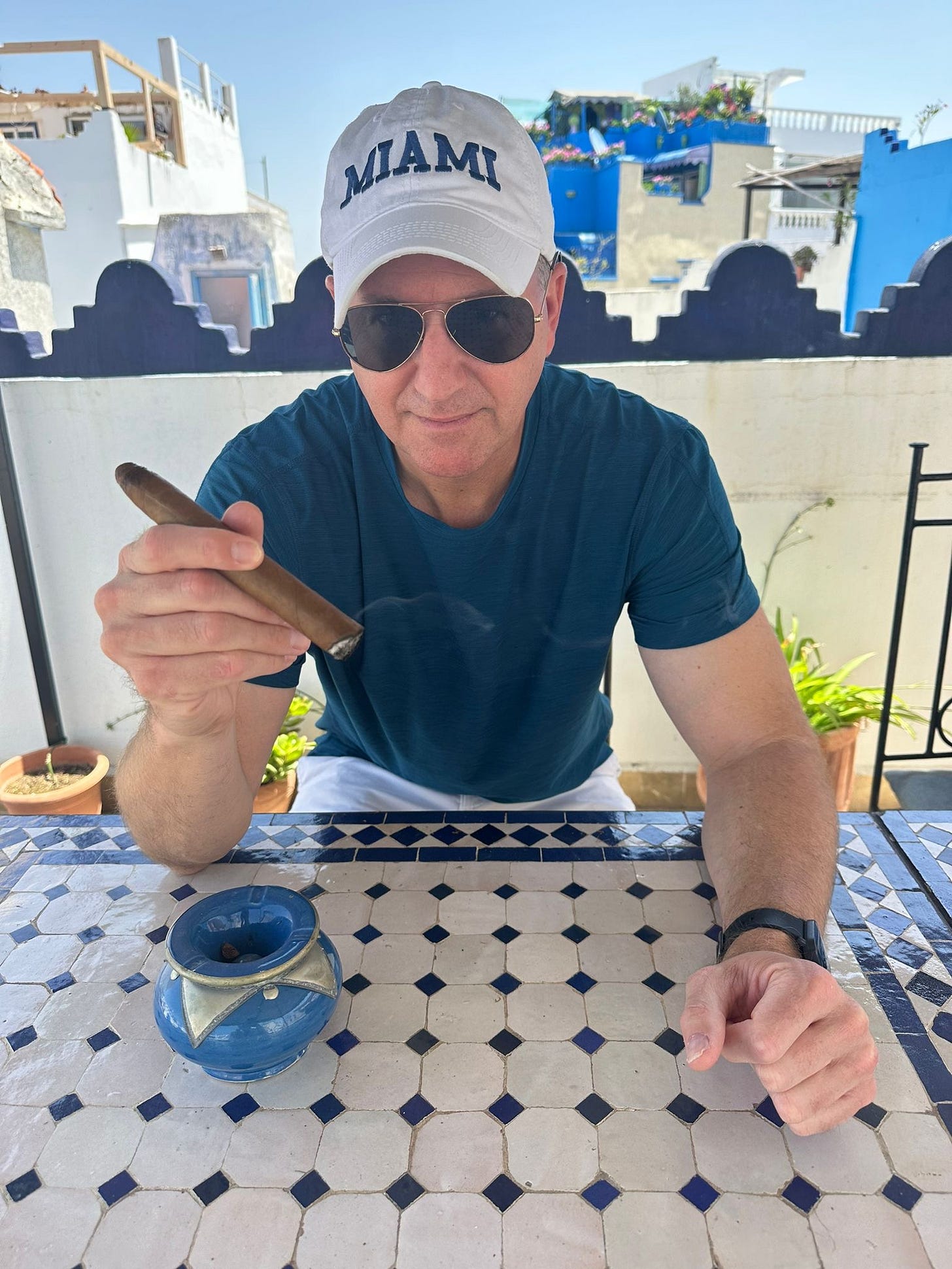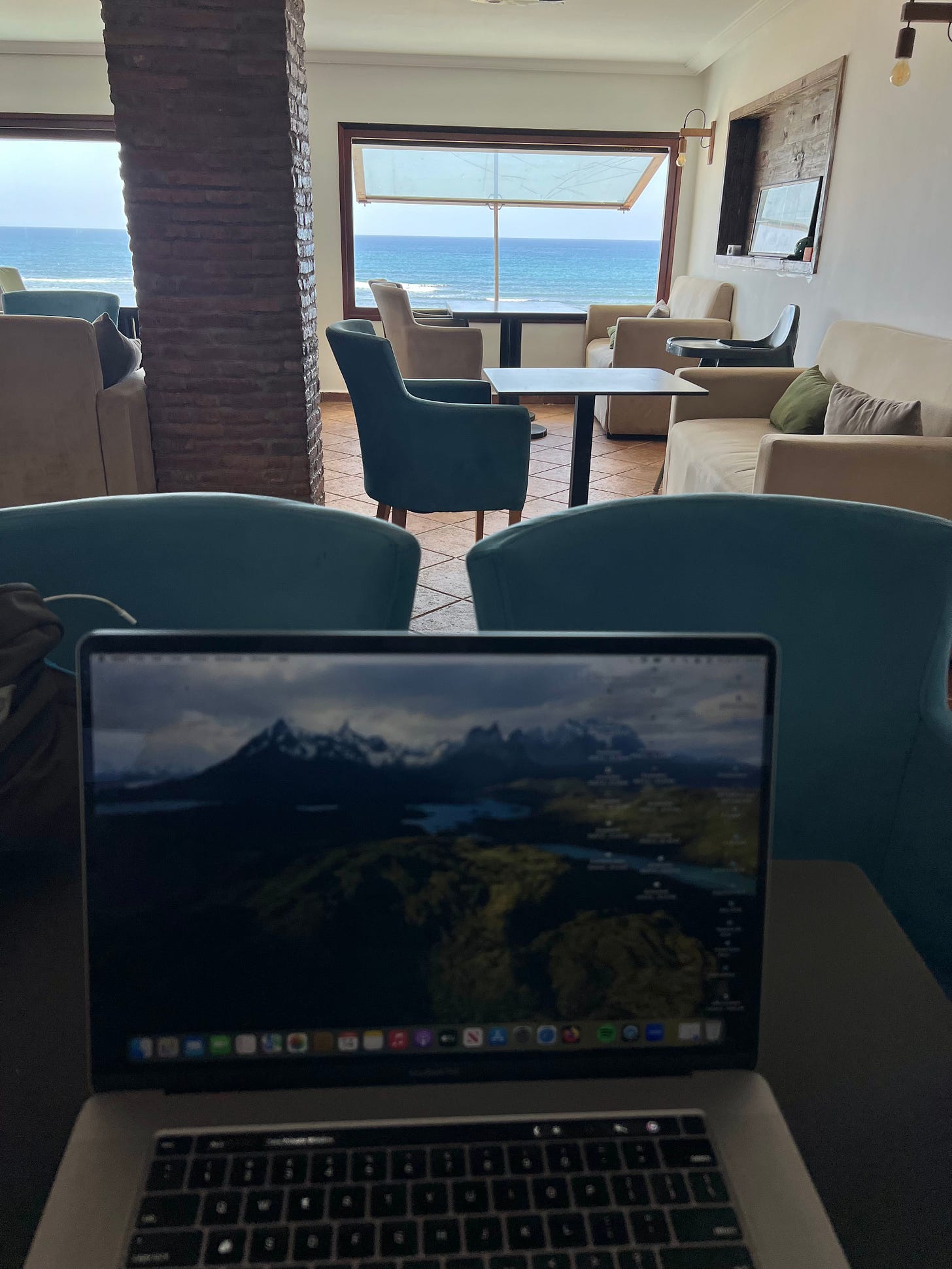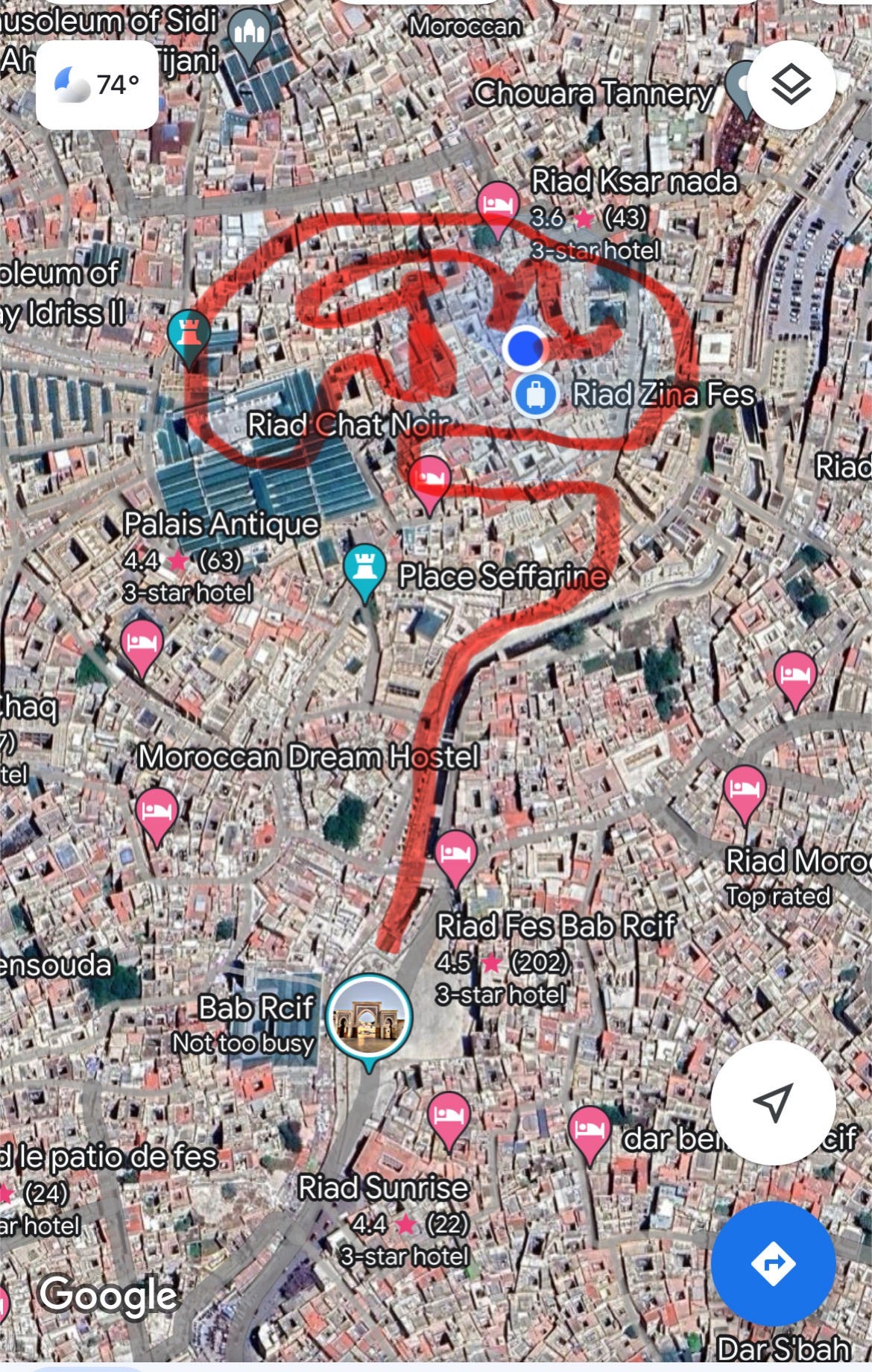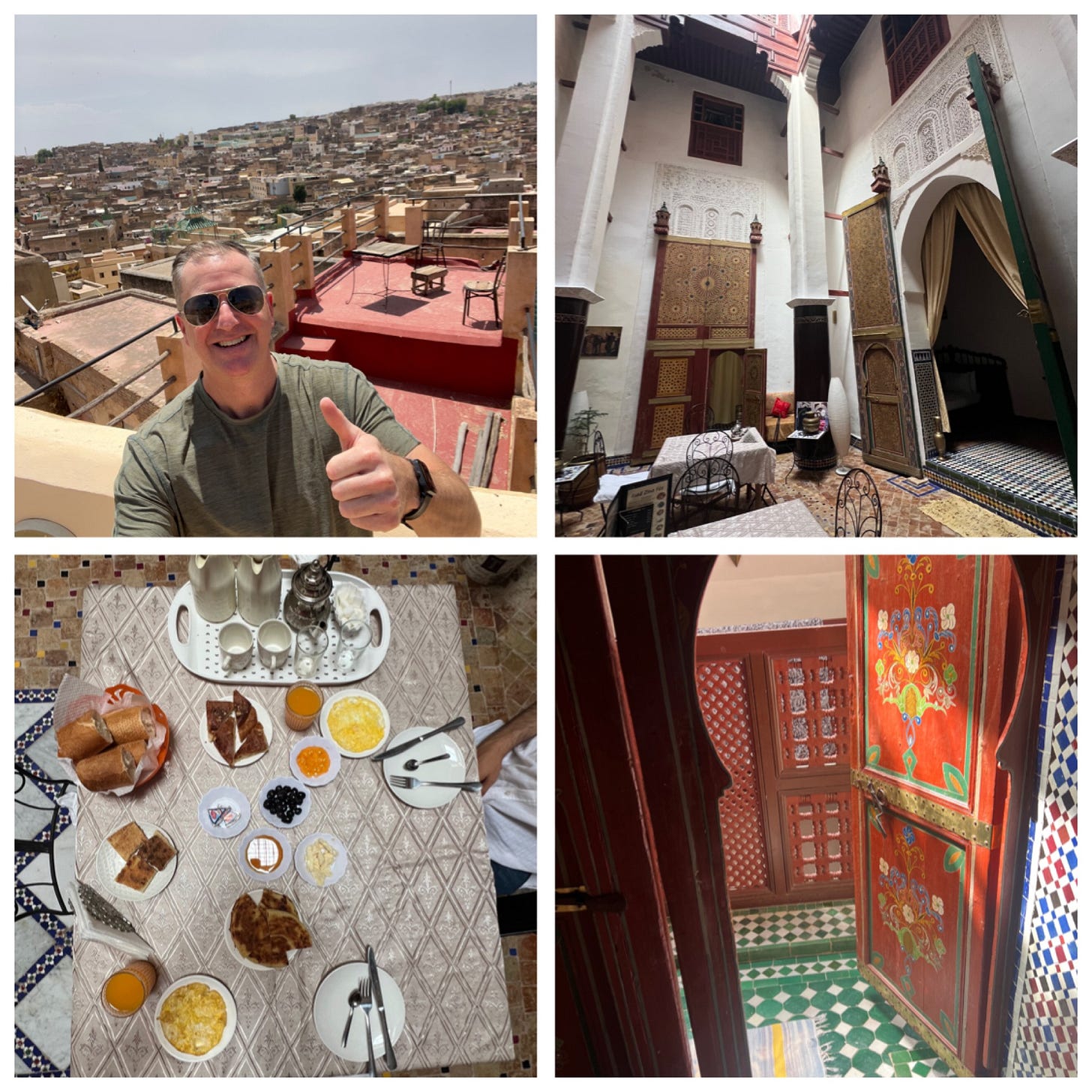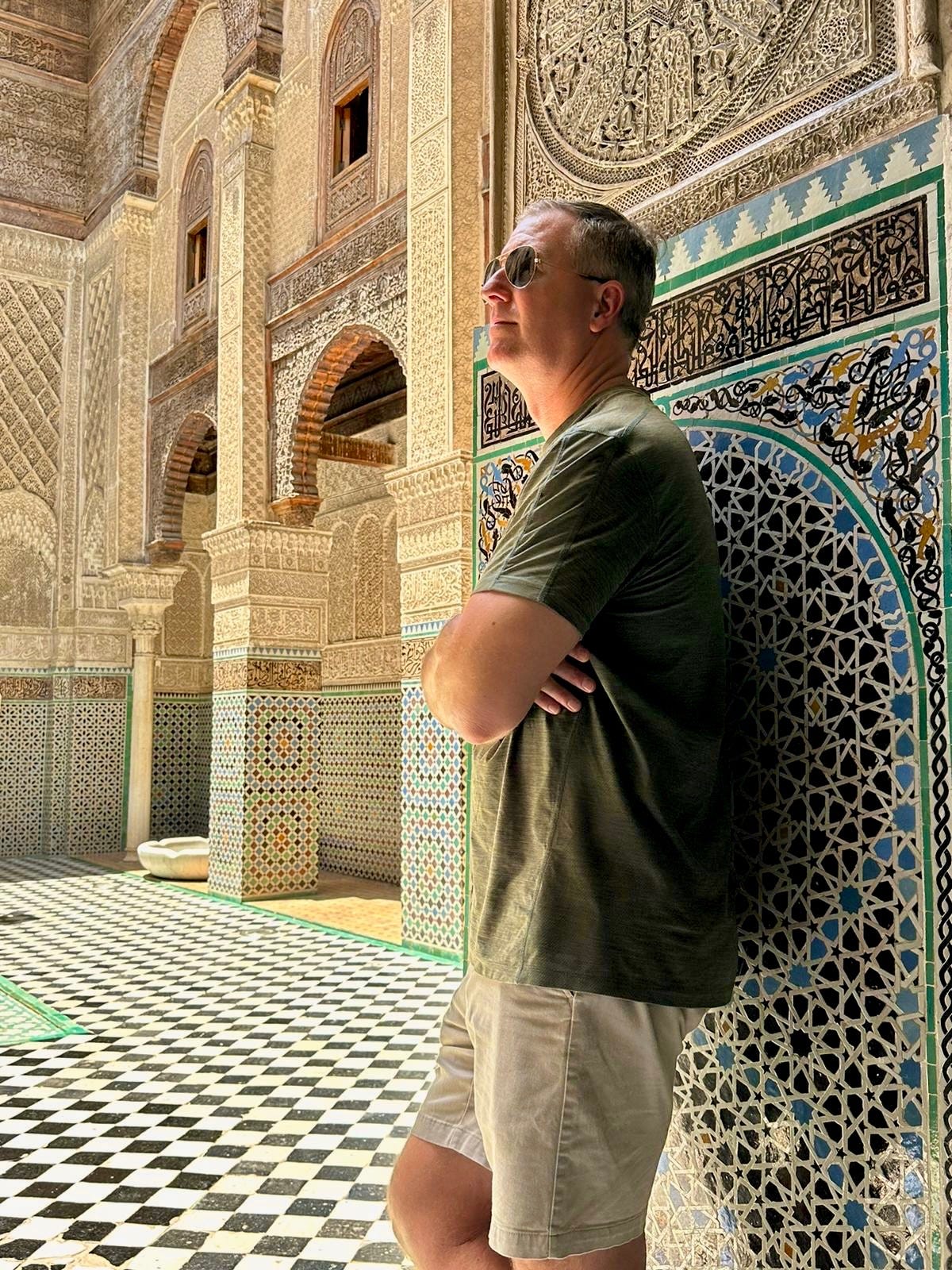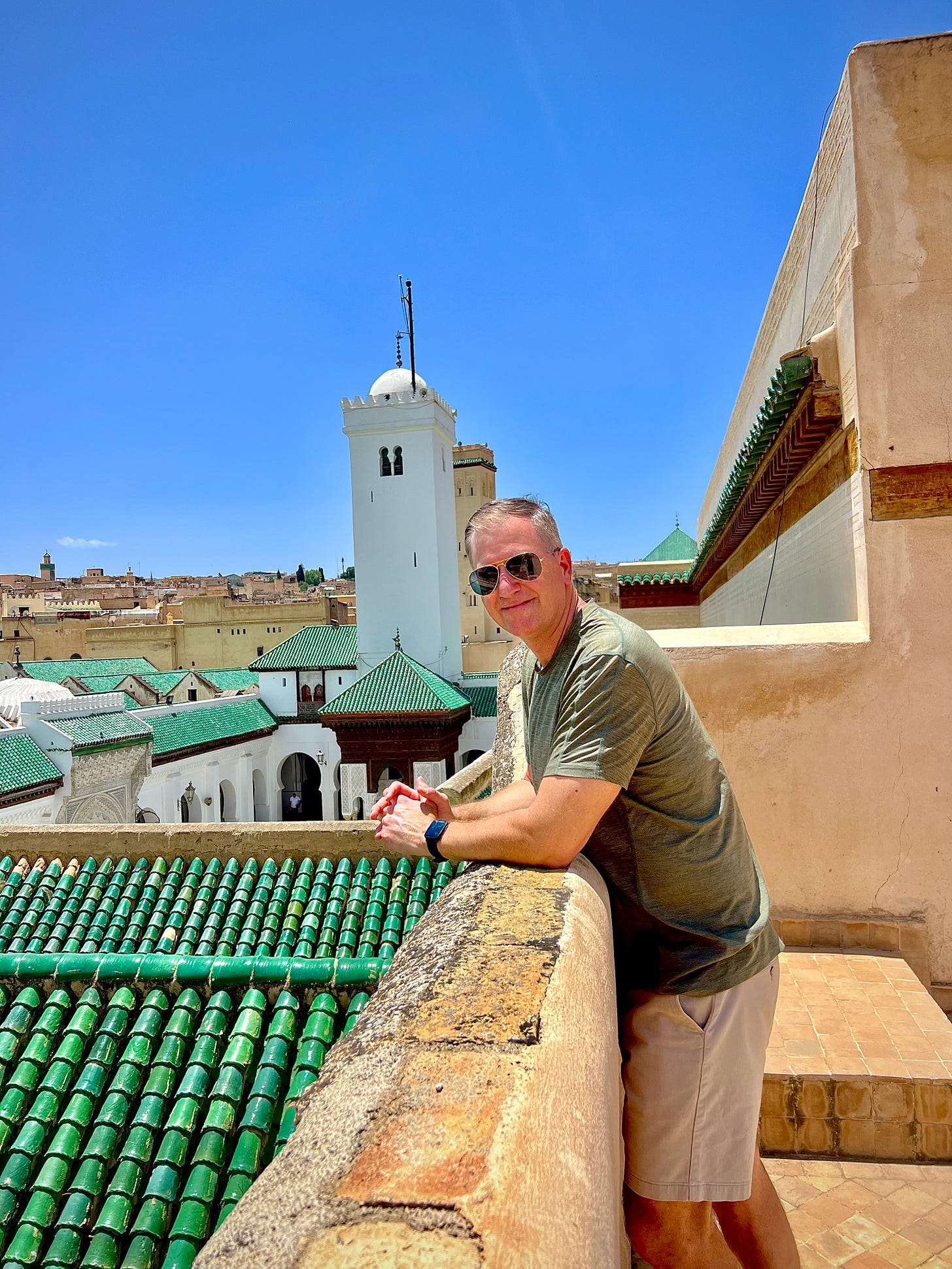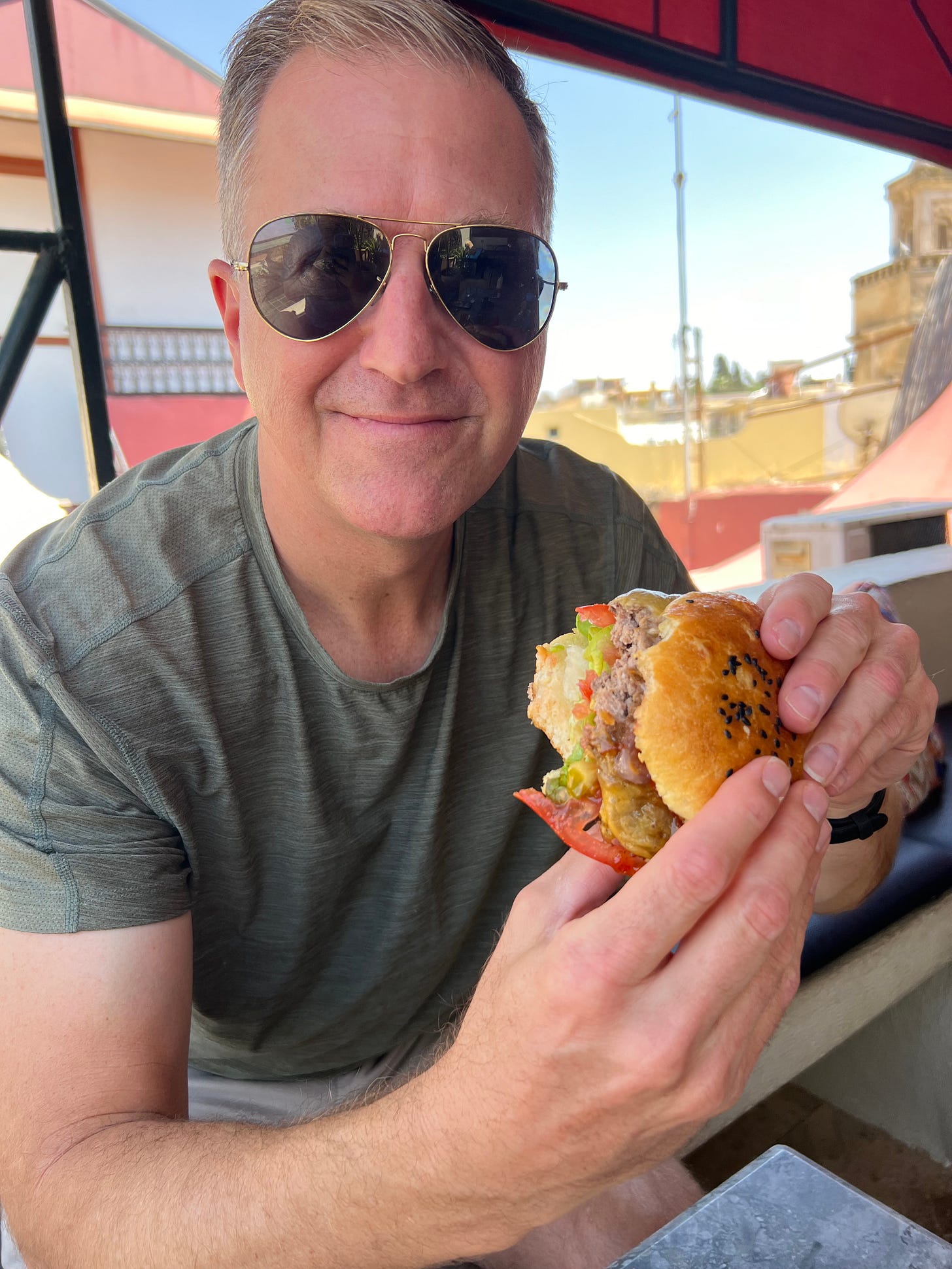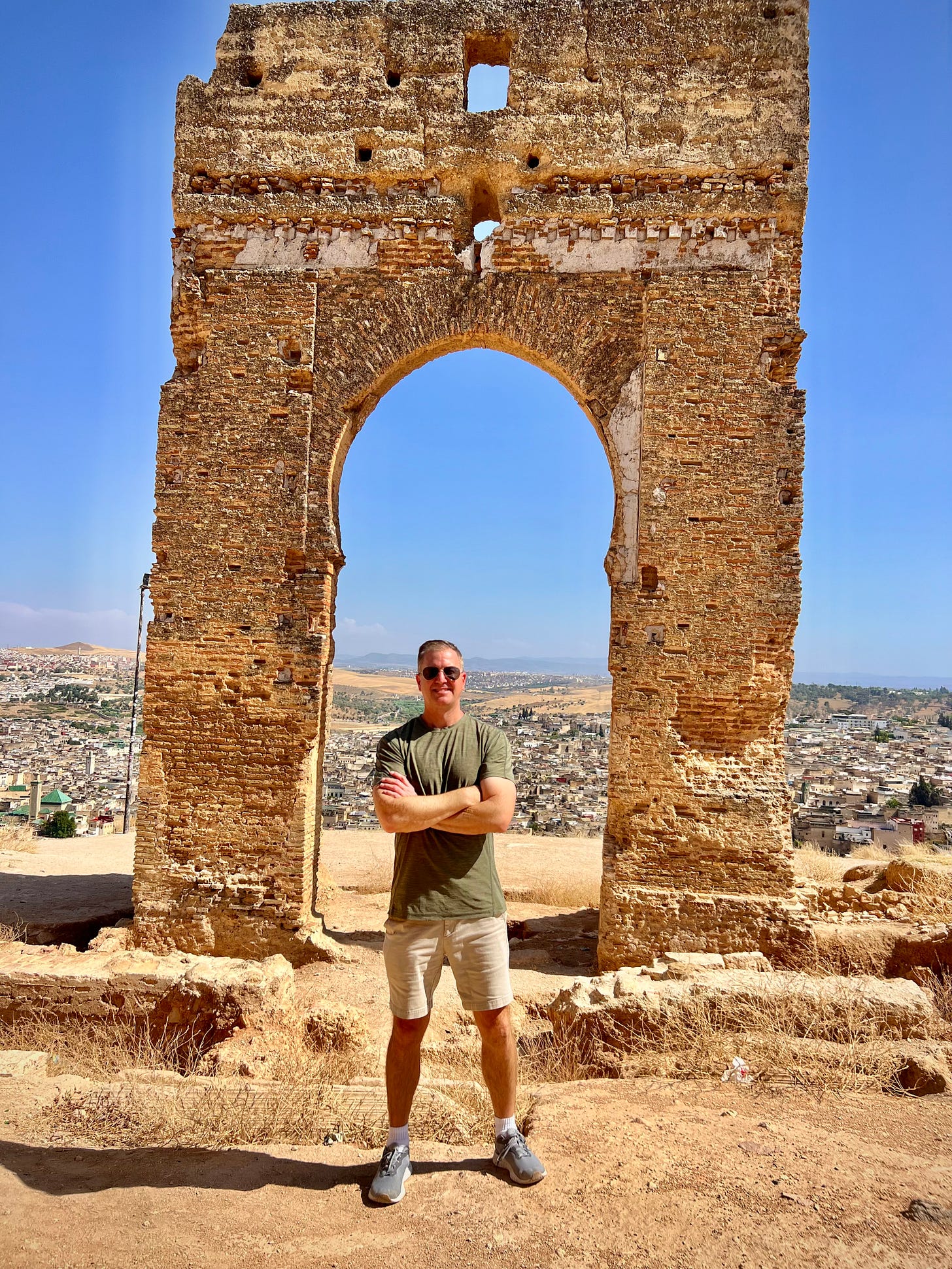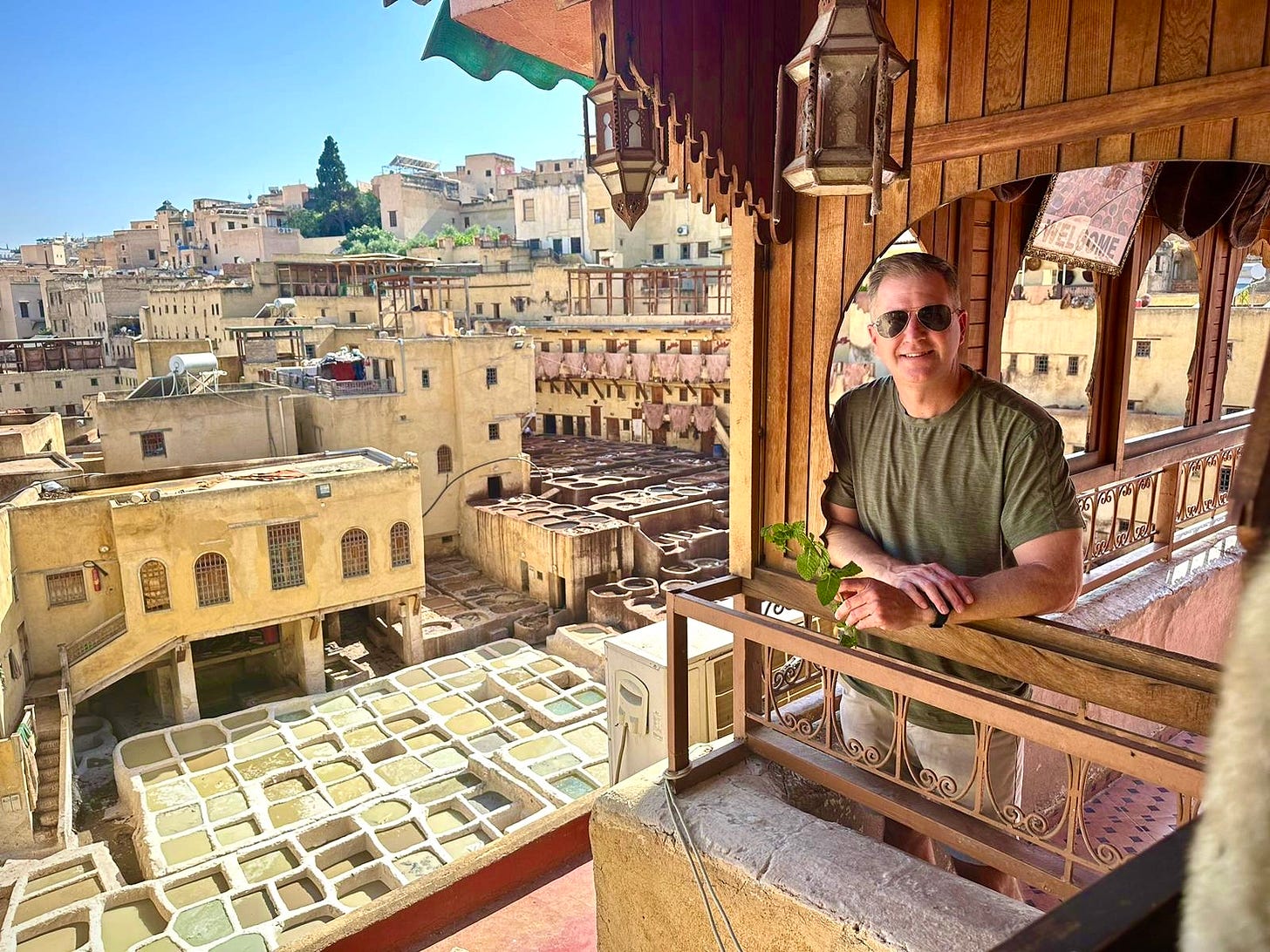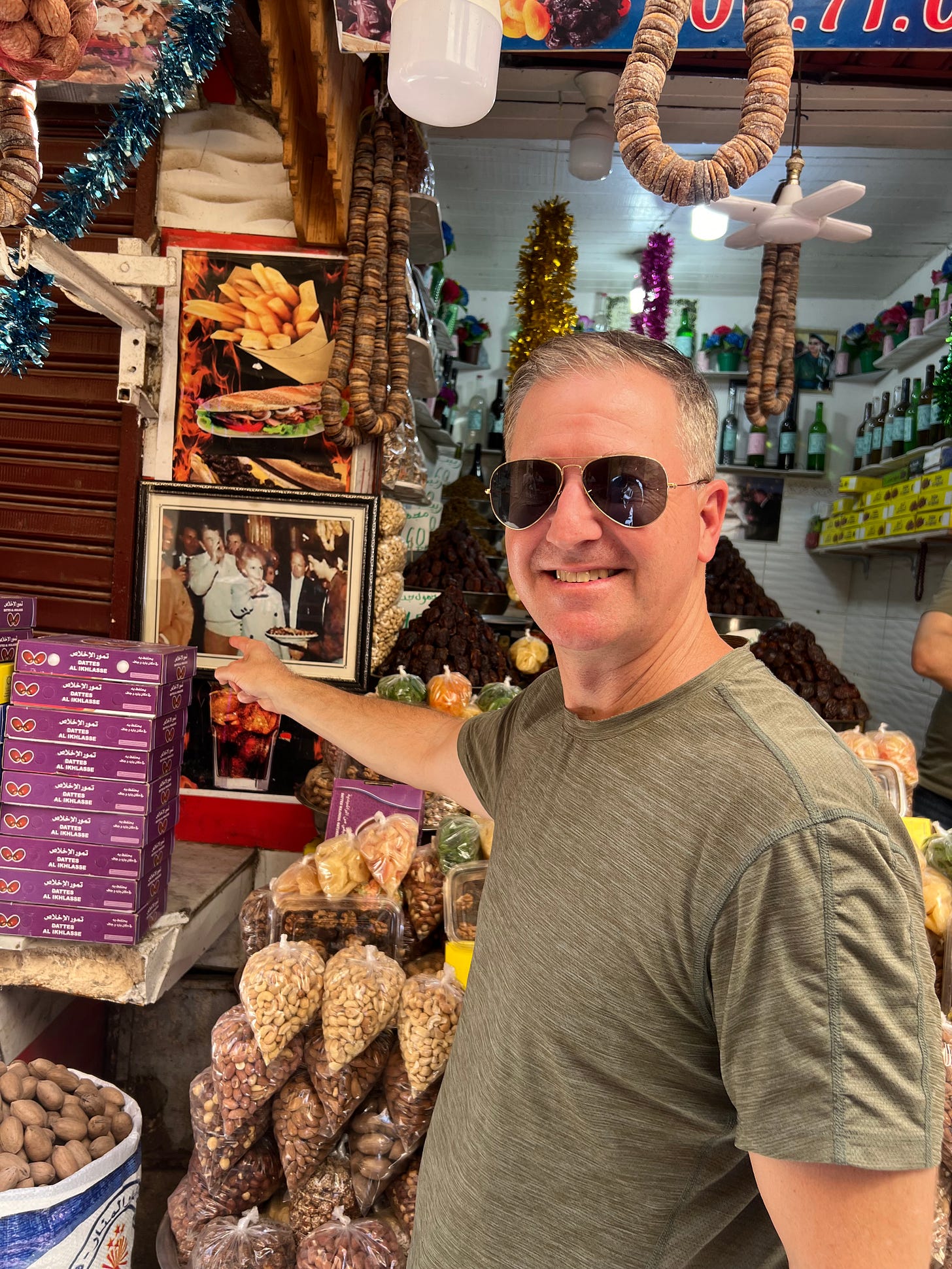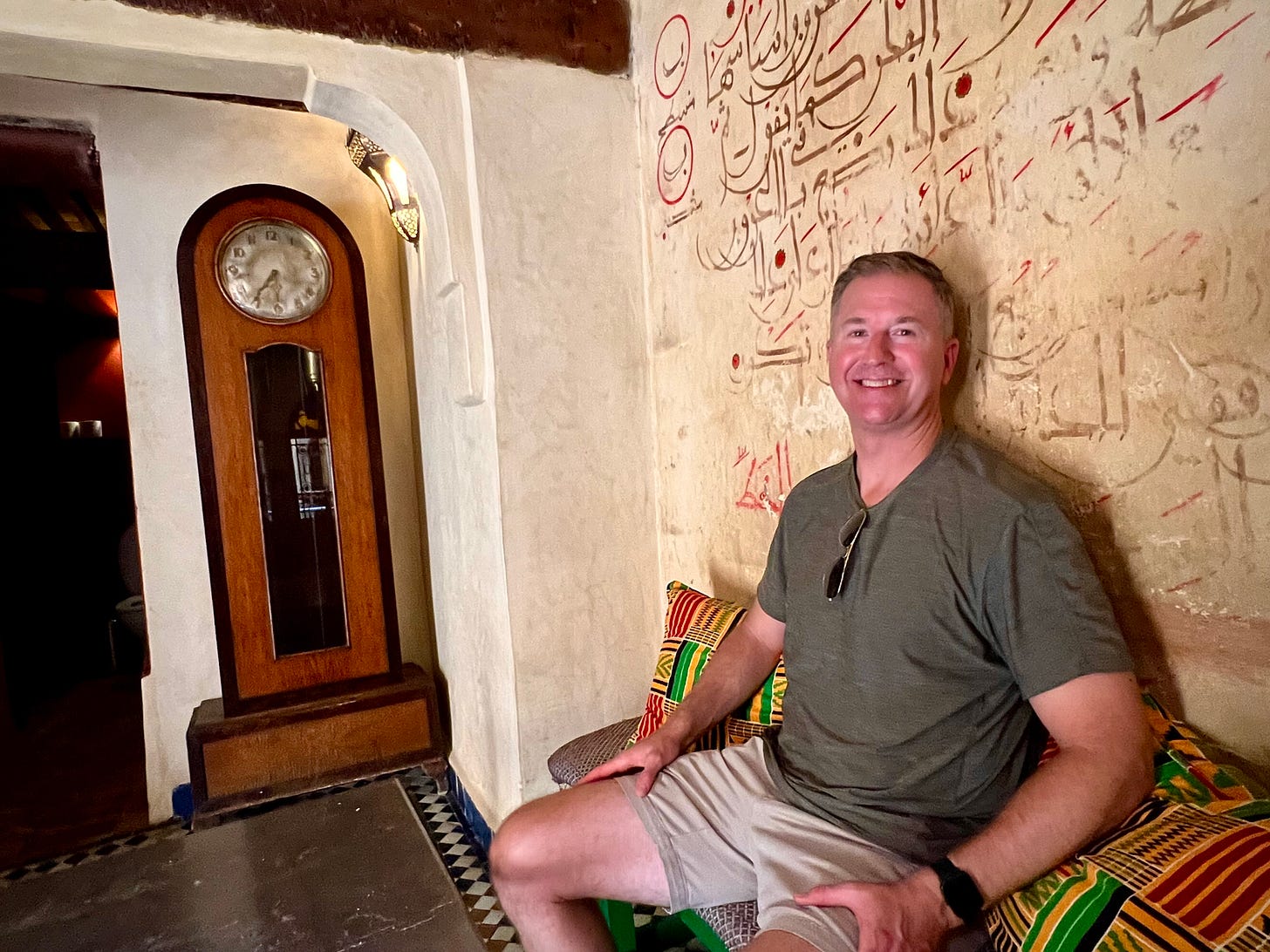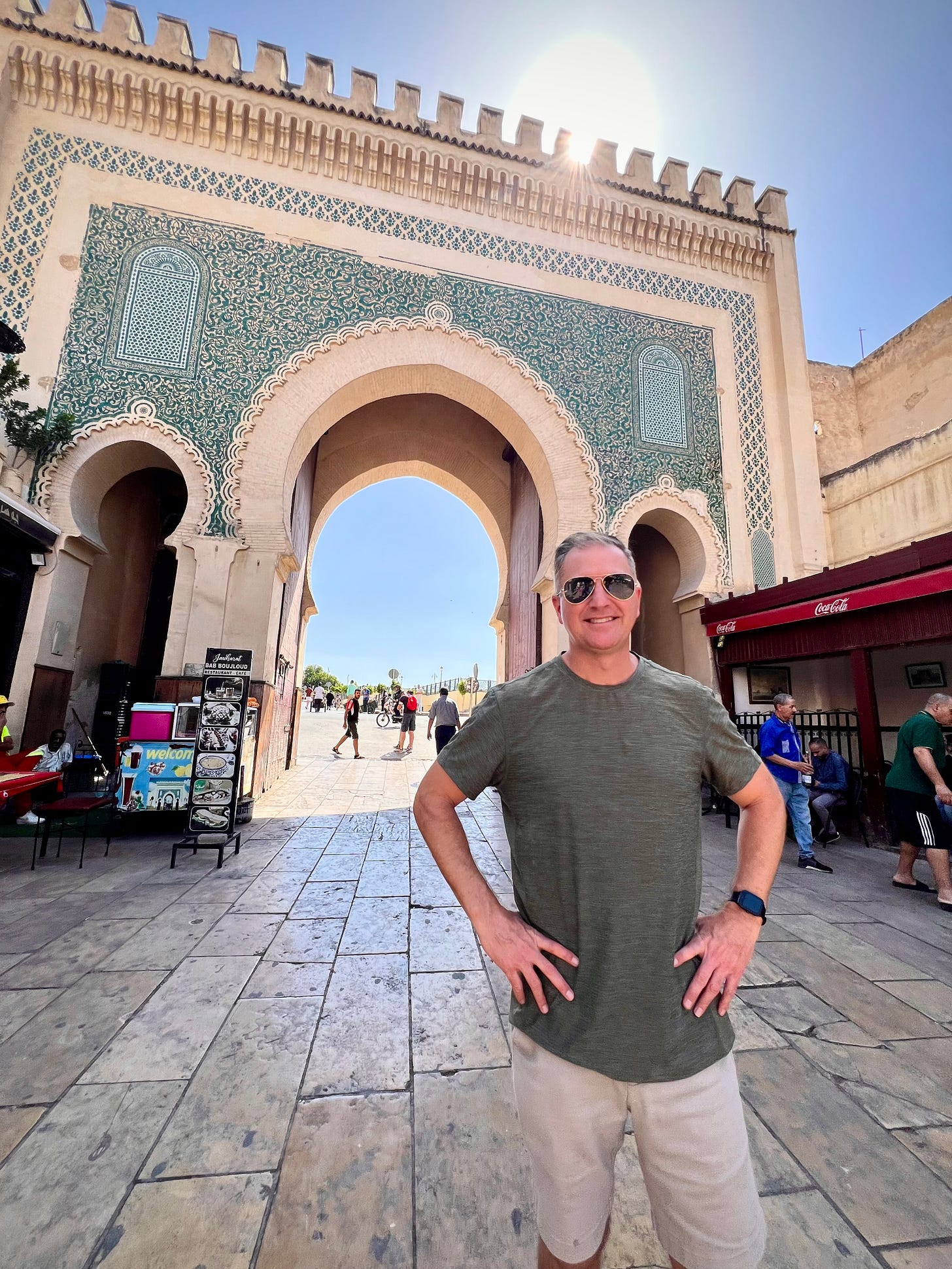A maze of Medinas: Asilah & Fez
In June, I had some memorable adventures to less explored medieval era Arabic cities in the heart of Morocco.
As I mentioned in my previous post from Morocco, after a full day in Tangier on Thursday, June 13th, we took a one hour taxi ride to the beach town of Asilah from where we were near the center of Tangier.
One of the great things about taking the taxi out of Tangier, is it allowed me to see the “other side” of Tangier. Not the historic side, where I had been for my first 20 hours in Morocco. As we left Tangier, we went through the more modern residential areas. We even passed by the construction of a very large soccer stadium.
The Moroccan soccer team made it to the final four of the World Cup in 2022. That was the first time they or any African team had made it that far in the history of the World Cup. It was an exhilarating time here for the people of Morocco.
In 2030, the FIFA World Cup will be jointly hosted by Spain, Portugal, and Morocco. Additionally, Argentina, Uruguay, and Paraguay will also each host a game in the 2030 FIFA World Cup. This will be the first time the World Cup will be held simultaneously on three continents, to commemorate the 100th anniversary of the tournament. The stadium we saw under construction will be used in that World Cup. Maybe I’ll be back for it. Who knows.
In the meantime, on this day, we were just hoping we would make it to Asilah (the beach town) in time for the sunset. And we did. What a glorious welcome!
My friend Stephen had been here before and he loved it. The only reason, he said, he hasn’t stayed in Asilah long-term is that it’s just so small. He got bored. But that also meant he knew all the great places.
On our arrival to Asilah, he took me to Cafe Daya, right on the beach. We had already eaten an early dinner in Tangier, but since we grabbed a table looking at the Atlantic Ocean, I picked up the menu. It was definitely time for ice cream and the ice cream sundae here hit the spot!
After dinner, we walked from Cafe Daya, while rolling our luggage, to the front gate of the Medina of Asilah. It was about a 10-minute walk.
What is a Medina anyway? It’s just the Arabic nomenclature for “city.” In most cases when people refer to a Medina in Morocco, they mean the old city. Think of it like the historic quarter of the city.
Most old Medinas in the Arabic world, and every single one I saw in Morocco, also are walled off. There are only a few entrances / exits and they are in specific areas.
It’s not usually not easy to navigate a Medina, especially with modern transportation. They typically don’t have wide enough streets for any cars, though you’ll often seen bicycles and motorbikes getting around inside the Medina.
The Medinas are also very tricky for Google Maps to keep up with, even for pedestrians. If I could get someone from Google on the phone, I would ask them to send teams of people to go map out all the Medinas in Morocco. Perhaps the final frontier for Google Maps.
The town of Asilah itself was originally constructed by the Idrisid dynasty, which ruled what is modern day Morocco between 788 to 974 AD. The Umayyad caliph Al-Hakam II rebuilt the town in 966.
I’m used to seeing many walled off communities in Florida — although we call them gated communities. But, you’d hardly call them old or central. They are typically newer and in the suburbs. So a Medina they are not.
But I love all the Medinas I visited in Morocco. And this one in Asilah was not only small, quiet, and beautiful, it also features a tower with my name on it — the tower of San Francisco. Thanks goes to the 15th & 16th centuries Portuguese investment.
The Portuguese conquered the city of Asilah in 1471 and built its fortifications. However, it was abandoned because of an economic debt crisis in 1549. All this building for very little time here.
Don’t spend the empire away!
Well, thanks to the Portuguese, the Moroccans in Asilah have some nice infrastructure in place. And guess what? Its ramparts and gateworks remain fully intact today.
It may seem a quiet old costal town with just about 31,000 residents, but don’t mess with Asilah. Neither the Portuguese nor the Spanish survived here long.
Yet, I seemed to thrive here — at least for about 24 hours anyway. But finding our hotel, the Riad Aicha wasn’t easy. Like I said, Google Maps needs to do a little more deep work here. Or maybe I need to stop being so spoiled. All my travels before about 2008 were without Google Maps or any kind of smart phone.
Luckily, the eternal hospitality of the people in Morocco made up for the lack of our modern day dependency on technological navigation.
As we walked up and down the same street several times looking for this Riad, we seemed frustrated. However, a group of young guys not far from the entrance of the Medina saw us and finally helped walk us right to the front door of our Riad.
Maybe somewhere in some other city someone else would have wanted to take advantage of us. But in Morocco, it seems almost everyone goes out of their way to help you. Someone should inform the U.S. State Department.
Once inside the Riad Aicha, we felt welcomed “home” by the husband / wife team that manage it. There was a beautiful entry way, almost like an interior courtyard and a gorgeous open air terrace rooftop, which was even better during the day (we arrived about an hour after sunset). We shared a room for about $35 USD for the night. I could have stayed here a week.
The next morning, we awoke to a very quiet Medina. We barely saw anyone around. A holiday was approaching, perhaps that’s why. But it seemed really quiet. Few businesses were even open. We found a little place to serve us breakfast. It was delicious and the equivalent of just a few U.S. dollars each. And the people there were so hospitable. They charmed us with their service.
Now I see why my friend Stephen has liked living and working remotely from Morocco for many months. The history, the architecture, the people are all great. And the dollar goes extremely far.
Here in Asilah, the colors also just pop.
“This is an Instagrammers dream!” I exclaimed. I mean this place has murals and colors that some cities put up just to draw people in a tourism culture ruled by Instagram.
I remember seeing lines 20 or 30 people deep in Nashville at made-for-tourist mural spots that all the “do it for the ‘grammers” had to get photos with. But here in Asilah, the beauty is natural. And there are no Instagrammers in sight.
I spoke too soon.
While Stephen was showing me around the Medina in Asilah, including a little stroll on the beach, and then back into the Medina, we came across a group of about a dozen tourists who were all middle-aged Chinese women. They all had cameras and smart phones and were posing like sorority girls on Broadway.
“What has our world come to?” I thought.
Ok, confession, I got some nice photos here too, but these ladies were taking it to another level. This was like something out of a Hollywood movie.
Then again, we’re in Morocco… every day here feels like a movie.
After walking around the Medina for an hour or two, we had pretty much seen it all. We went back to the rooftop of our Riad. I popped open my laptop to catch up on a little work. We also enjoyed some cigars while taking in a view of the Atlantic Ocean, just a few streets away.
From there, we checked out and then went back to Cafe Daya, where I was able to get lunch and then use their WiFi to do some remote work of my own, including a Zoom call. They had a nice second floor area that was mostly quiet with great ocean views. I could stay here forever.
But, like I said, Asilah is a small, quiet beach town and Stephen just wanted to take me here for one night. We were not even here a full 24 hours before we found a taxi to take us about a 10-minute drive to the train station. It was a very small train station, but we got there quite early (about an hour or so before our train) because there are not always very many taxis in this town and we didn’t want to try to rush or cut it close.
There were just a few people here when we arrived. About 15 minutes before the train was set to depart, about a hundred people showed up. After all, it was the start of a holiday here in Morocco.
At this time of year, Muslims celebrate Eid al-Adha, commemorating God’s mercy on Abraham’s son Isaac by sacrificing the lamb/goat instead. One person described it to me almost like Thanksgiving in Morocco. Instead of a turkey, they have a lamb. And all members of the family gather together, to give thanks.
Most of the people riding with us from Asilah on this train, which originated in Tangier, and on the way to Fez, were traveling to be with family with all the Thanksgiving travel feels.
Here in Morocco, it’s best to reserve a seat on the train in advance. It’s not much more money to get a first class seat. Unfortunately, we had only booked the train the day before and all the first class seats were taken. This meant we were riding in a train car that had 8 seats. Four on one side facing four on the other. Inside our car was a nice young couple with two young children (both under 7). Then there was Stephen and I, and two other young adults.
The ride was four hours one way from Asilah to Fez, but the train makes lots of stops. One stop lasted for a good 20 minutes. Another, almost as long. We would see patrons on the train getting out and taking smoke breaks. I don’t know if these breaks were exactly planned for this long or what was going on, but it turned a four hour train ride into about five.
Luckily, we could walk around a little bit, but the train was pretty packed. And we didn’t seem to have much, if any A/C in our car. Thankfully I had plenty of podcasts, audio books, and even some movies on my tablet to keep my mind occupied. We had eaten a bit before the ride, but not enough. I had a snack bar. We were able to hold out.
Somewhere during our train ride, Stephen struck up a conversation (in Arabic) with the father of the children in our train car. Later he told me that the man had invited us to come to their house on Sunday evening to share lamb with them for the Eid al-Adha holiday. We might have taken them up on the offer, but we were only going to be in Fez for two nights (departing Sunday morning). The holiday celebration was on the day we would be leaving Fez.
When I later learned about this offer it really struck me as wild. The Moroccan people are just so hospitable. They are a people that truly live their faith and are very welcoming to strangers.
Late on this Friday night, five hours after we had left Asilah, we arrived in Fez around 11:20 PM. Through WhatsApp, Stephen was in contact with the owner of our hotel, the Riad Zina Fez, to let them know we were arriving a bit later than expected.
We took a short 7-minute taxi ride from the train station to the entrance of the Medina — the old part of the city of Fez. From there we had to navigate — by foot, with our luggage — to our hotel. But Google Maps barely helps you and certainly doesn’t get you all the way there, especially when your hotel is deep in the center of the Medina. You just go in concentric circles and hope to find the right path on very narrow pedestrian-only streets with high walls.
Fez is another world and there are some major technological limitations when you are navigating through a 9th century medieval city, the first imperial city in Morocco! What a labyrinth of a city! It makes navigating through a city like Venice a piece of cake!
After spending about a half hour navigating by foot, with our luggage, we had multiple locals trying to help us find our Riad. Several could not figure it out, nor had they even heard of it.
It was now around midnight. We finally had a young man offer to walk us to the Riad. From the point where he was to the point he took us was about a 15-minute walk. And there’s no way we could have found that place without him. It was wild. We thanked him with a nice tip.
One friend back home later told me he got lost in the Medina in Rabat (the capital of Morocco, which I didn’t make it to). Stephen laughed when I told him this. He said that Medina is easy to navigate compared to Fez!
Visiting Fez was one of the most authentic experiences of seeing what I’d call “the real Morocco.” The place is so confusing even locals who were born and raised here get lost. But that’s why I came here — to chart the course — so future Fearless Journeyers will know the way!
Would you be interested in coming here with me on a future Fearless Journeys group trip? I’d like to bring a group here sometime in 2025. Drop me a line if this interests you.
And yes the “Fez” hat gets its name from this city. But there’s so much more to discover.
***
Our hotel, the Riad Zina Fez was really amazing. We had to take our luggage up about 4 flights of stairs to our room, but we had a great room. Inside these Riads, there are large interior courtyards. It looked magnificent from the lobby level alone, but also nice to step out of our room and look into the courtyard. In the morning, the husband/wife team who own/manage this Riad prepared a nice breakfast for us at a reasonable cost.
From that point on, we went out and wandered around the Medina, carefully tracing our steps so we would be able to find our way back. While looking through some shops, we were approached by a teenage boy named “Karim.”
He offered to take us around to some shops. Stephen had been looking for a few new shirts and the bargains here were pretty good. We weren’t so sure at first. We knew Karim would probably want money. But then we realized how easy it was for us to get lost and this Medina was wild. We took him up on the offer to help us.
When I asked the teenage boy for his name again he said “Karim — like Kareem Abdul-Jabbar!”
“How do you even know who that is?” I asked him. I wasn’t thinking it was because he was not American, but because he was so young. Kareem Abdul-Jabbar was before my time! But I guess when your name is the same as an NBA legend, you know it.
When other locals throughout Fez saw us with Karim they would often comment how great of a kid he was. He knew everyone and they were fond of him. I told him at one point, “Karim, you’re going to be the Mayor of Fez one day.”
Sometimes we would be in a store in Fez and instead of exiting out the front door where we came in, Karim would ask the shop owner if we could go out some side / back door. It was like a hidden exit into the maze of Fez. Sneaking out of this hidden doorways almost like something out of Narnia at times.
He also took us to great spots from which to get amazing photos. He also brought us to a very beautiful mosque that was part of the University Kairaouine. While everyone was scrambling for photos by a side door of the mosque, he took us to a hidden rooftop to see it from above.
This kid was going to get a nice tip. Taking him up on his offer to show us around may have been the best move we made all day, despite the fact he was not an official tour guide. To be one, you have to take classes and get certified through the local regulatory body. There are reasons for this. But sometimes you can just stumble upon a local gem like Karim who can get you around to all the hot spots without having to be in a larger tour group.
Stephen asked Karim to take us to the entrance/exit of the Medina and we told him that we’d call him when we returned. At this point, we had his number on WhatsApp.
Once we stepped outside the Medina, there were normal modern roads. Stephen had us take a short 5-minute taxi ride to the other side of the Medina. That’s where we went to a well-known restaurant called Cafe Clock. And the item on the menu it was most famous for? The Camel burger.
I had never eaten camel before in my life. I didn’t know what to think. But when in Morocco…. I took my first bite. OH MY. It was… DELICIOUS! I don’t know how to describe it. Somewhere between the taste of cattle and lamb?
We sat on the rooftop deck of Cafe Clock — definitely the best seats in the house. We had a great view of the Medina including of a magnificent minaret from one of the mosques.
Once we finished lunch, we found a taxi to take us to some ruins on the outside of the city that are part of Marinid Tombs. They were originally a royal necropolis for the Marinid dynasty, which ruled over Morocco from the 13th to 15th centuries.
This was a really magnificent viewpoint and the ruins of these tombs look even older than 600 years. Around it and down the hill is a large cemetery. It seems a lot more recent, so perhaps this is where many are still buried today.
Once our driver took us back to the entrance of the Medina, we contacted Karim to meet us so he could walk us back to our Riad. He insisted on first taking us to the tannery. I was tired but I gave in. So did Stephen, who was planning to take me to a tannery in Marrakesh. But after we saw the one here in Fez, he said we wouldn’t need to see the one in Marrakesh. This one did the trick.
While getting a tour of the tannery, they gave us a mint leaf to carry around. You can see it in my hand in the photo below. Our guide told us it serves as a “gas mask” from the smells. It must have worked. The smells weren’t as bad as they had talked them up to be.
It was a really great tour. A huge tannery and just a magnificent site to see, but one note here. At the start of the tour, the tannery guide told us the tour was free. After the tour, he was upset we didn’t want to buy anything. Then he demanded some kind of fee.
“I thought the tour was free,” I said.
“Yes, but only if you buy something,” he said.
Every day is like a movie here. Then again, we’re in Morocco…
***
As we wound our way back through the Medina on the way to our Riad, we passed by many shops, including one with some great fruits (dates are huge here!) and sweets. You can buy any number of individual fruits or sweets and give the owner a few Dahrim. It’s almost like giving them 10 cents in USD.
I was getting some dates from one shop owner. That’s when I saw the photo of President Reagan and First Lady Nancy Reagan. They visited the markets of Fez four decades ago (it must have been a nightmare for the Secret Service!) and the shop owner here still has the photo displayed proudly.
This afternoon gave me some reminders that time waits for no one. I saw an old grandfather clock at the Cafe Clock restaurant. We visited ruins that were once great structures of a powerful dynasty. We saw a photo of a U.S. President that changed history. But all of these things are now but a memory. Our time on this planet is just a blink of an eye.
That’s why I like to travel. It expands time. It fills it with more memorable moments. It also has no regrets. Time waits for no one. We’ll all be gone soon. You must make your time count!
Well that’s exactly what we did with the rest of our evening. We had Karim walk us to the Riad Blue Oasis for dinner.
When you have dinner in a Riad like this, you’ll feel like a king in Morocco, where the dollar goes far. This place was quite expensive for Fez, but still a bargain if I was in Miami.
You might also feel like a servant in Morocco, especially when they don a “Fez” hat on you in the city of Fez— from where this headwear originates.
The Riad Blue Oasis is a luxury hotel with a storied history. We had a salad with over 7 different ingredients that you mix on your own plate. We had beef as the main course. And we topped it off with a traditional Moroccan dessert called Jawhara, which is basically sweet, crunchy layers of fried pastry scented with orange blossom cream and toasted almonds. The cream is made with milk, sugar, cornstarch, and cinnamon while the pastry is standard Moroccan werqa. Served with a side of oranges — it feels more healthy that way!
On this Saturday night, we were the only table being served at the Riad Blue Oasis, which meant we had constant attention from our server. And, unlike Amsterdam, the Moroccans let you smoke anywhere, inside or outside. We topped off the meal with cigars I had brought with me all the way from Antigua Cigars (in Guatemala) while enjoying some great Moroccan wine.
This was a night to remember as I charted the course in the medieval city of Fez!
Fez was a fantastic city — one of those places that is so unique from any other city I’ve bee on earth. A true treasure. It was not easy to get to or to get around, but it made it fun and quite a memory to behold.
Fez is somewhat known for those looking to dive deeper into Morocco, but it is still not on most people’s Morocco itinerary. It’s a little less touristy. More authentic. Medieval. 9th century feels. A walled city that feels like a maze. You get lost over and over again. But you keep going anyway.
As fun as it was to enjoy this city, we had more of Morroco to see. On Sunday morning, June 16th, we woke early. We had quite a journey ahead of us on this day. More on that in my next report…
What I’ve been consuming this week:
PODCAST: Listened to Joe Rogan’s interview of Peter Thiel. It was over 3 hours long, but very fascinating, hitting on all sorts of topics, including why he believes California has not yet collapsed economically. I was especially interested in this since the Economic Club of Miami, where I serve as Executive Director, is hosting Peter Thiel for a fireside chat on October 28. Learn more here.
BOOK REVIEW: We are wrapping up our Fearless Journeys book for July & August, Stillness is the Key by Ryan Holiday. Read my latest book review here and consider joining our live Zoom session to discuss the book this Tuesday, August 27 with my friend and Fearless Journeys member, Doug Pestana.
NETFLIX: More Kevin Hart, please. I watched “Night School” and “Me Time” on Netflix this week. I thought Night School was the better of these two, but Kevin Hart never disappoints. I can’t stop laughing. I also watched two other films this week, My Best Friend Anne Frank and The Union (with Mark Wahlberg and Halle Berry). Still in recovery from tearing my Achilles heal 23 days ago… has given me more time for movies.
ICYMI: Check out my latest podcast episode #145 with Evan Rally and learn about his Ride of Passage adventure travel experiences through Thailand and why he moved there from the United States five years ago.





